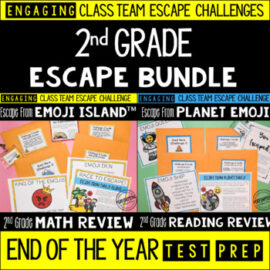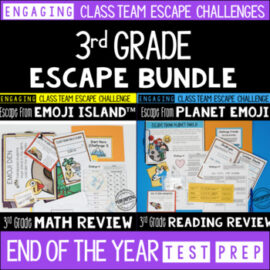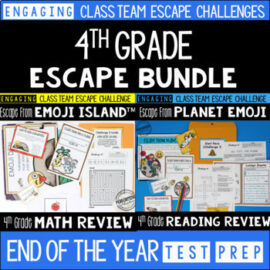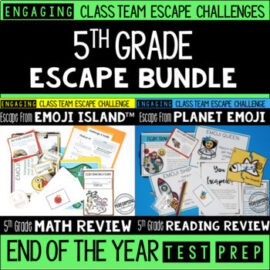I’m always looking for new, fun ways to have students learn and practice our standards. This year, the rise in popularity of escape rooms and escape classrooms really inspired me to figure out how they actually work in the elementary classroom. This post will give you some hints on how to modify the escape room idea for an easy-to-manage classroom escape challenge!
Want tried and true pre-made games? Click here.
Looking for classroom photos of my escape rooms in action? Click here for my Escape Room Tips & Tricks blog post.
Choose the right theme
Something that you really have to think about when designing an escape room for the classroom is what theme would be appropriate for elementary kids. This may seem obvious, but it’s actually harder than it seems to find inspiration for a theme. Common escape rooms are complex topics like Da Vinci, or scary themes like zombies.
I tried to think of a topic that was similar to popular escape rooms, but not as scary, and more relevant to kids their age. What I ended up coming up with was Escape from Emoji Island™.
Teams are Key
I’m not sure about you, but I wasn’t super excited about 30 kids running around the classroom looking for one clue. I didn’t think it was even possible for that many kids to work together in the way that an escape room traditionally works.
I knew teams were the way to go, but I had to think really long and hard about how to make this work. If one team finds a clue, then the others are obviously going to see it before they even solve the puzzle. I had to consider all of the different ways that kids could get by without doing the work to pass the challenges.
The way to do this is to have students actually know where to find the next clue. I know that doesn’t sound very exciting, but I put all of my challenge envelopes in one place. In order to get from envelope to envelope, they have to solve puzzles by answering questions that are standard-aligned. They even have to answer an additional question to even be able to open the envelope.
The envelopes are all kept safe by the King of the Emojis, except the final “You Escaped” envelope that the winning team finds. The Emoji King won’t let teams have the next envelope until they show him the correct passcode from the current challenge. The teacher can verify this, or you can choose a student to be the Emoji King.
In my escape challenges, only one team escapes. It’s a race to be that team. I even have badges for the team that escapes first to wear after. #braggingrights
Keep the Prep Simple
Let’s be honest. This is a 90 minute review activity, and a valuable one, but it should not take you three hours to prep it! I heard a friend telling me that she tried an escape classroom, and to modify it for teams, she needed one envelope for each team for each step. She had almost 30 envelopes! Nope, I’m not that committed to any activity.
When I designed mine, I made it so that you need the following supplies:
- 5 large manilla envelopes
- 1 letter envelope
- A brass fastener, baggies, a few other misc. supplies (depending on which one we’re doing)
That’s 6 envelopes total. Make a copy of each challenge for each group and put them all in the same folder.
Also, don’t include too much that needs to be cut. I limit this to one activity per challenge that involves cutting. Even with students to help, you don’t need that many pieces to keep track of.
Build in Accountability
A big concern I had about escape rooms in the classroom was participation. It’s so important to think ahead and plan what you’re going to do if certain students really take over your challenge. It will happen with your high-fliers. They know the content well and the competitiveness of racing to escape first will drive them to do all of the work while their team watches.
I have a few suggestions for this:
Have students split the work for each challenge. That means that each challenge should have a number of questions that is more than how many kids are in the group.
Find a creative way to take students out of the game if you need to. I use “You’ve Been Kidnapped” cards that I give to students who are taking over the team and not letting others participate, or to disrupt a team that is racing past the other teams. They have to sit out in the “Emoji Den” for 5 minutes when I give them this card.
Lastly, have a place where all students can write answers and the codes. Make sure to check these as they go to make sure they are using them. I designed mine as a booklet where they keep track of the emoji codes and the answers to the quick questions on the envelope.
Pre-Made Escape Challenges
I currently make escape challenges for grades 2-6. Click on your grade level to see the bundle and individual resources included. In each bundle there are multiple pages of resources, so make sure to click the next link to see them all. This blog post contains the examples from my math review line: Escape from Emoji Island™.













